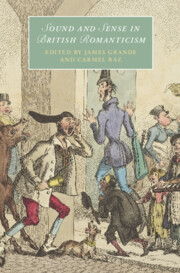Refine search
Actions for selected content:
71 results
An attempt to estimate the creative state during co-creation by using a hidden Markov model
-
- Journal:
- Proceedings of the Design Society / Volume 5 / August 2025
- Published online by Cambridge University Press:
- 27 August 2025, pp. 499-508
-
- Article
-
- You have access
- Open access
- HTML
- Export citation
Chapter 6 - Acoustic and Auditory Phonetics
-
- Book:
- English Phonetics and Phonology
- Published online:
- 17 October 2025
- Print publication:
- 10 July 2025, pp 79-94
-
- Chapter
- Export citation
Felt-Quality Hedonism, Alienation, and the Spirit of Resonance
-
- Journal:
- Utilitas , First View
- Published online by Cambridge University Press:
- 07 July 2025, pp. 1-22
-
- Article
-
- You have access
- Open access
- HTML
- Export citation
Chapter 3.7 - Pressure and Cardiac Output Measurement
- from Sec 3 - Physics
-
- Book:
- Dr Podcast Scripts for the Primary FRCA
- Published online:
- 19 June 2025
- Print publication:
- 03 July 2025, pp 383-405
-
- Chapter
- Export citation
12 - Charismatic Speech Breathing
- from IV - Persuasion and Algorithms
-
-
- Book:
- Manipulation, Influence and Deception
- Published online:
- 10 June 2025
- Print publication:
- 24 April 2025, pp 250-276
-
- Chapter
- Export citation
6 - Screens and Time
-
- Book:
- The Comfort of Screens
- Published online:
- 10 April 2025
- Print publication:
- 17 April 2025, pp 104-121
-
- Chapter
- Export citation

Ancient Mythologies of the Wilderness
- Narrative, Nature, and Religious Identity Formation from the Babylonians to the Late Antique Christians
-
- Published online:
- 10 April 2025
- Print publication:
- 17 April 2025
5 - Station Rhythm Enskilment
-
- Book:
- Bus Station Hustle
- Published online:
- 09 February 2025
- Print publication:
- 13 February 2025, pp 92-113
-
- Chapter
-
- You have access
- Open access
- HTML
- Export citation
Chapter 7 - Structural Loading and Response
-
- Book:
- Wind Turbines
- Published online:
- 24 January 2025
- Print publication:
- 19 December 2024, pp 138-176
-
- Chapter
- Export citation
IRROTATIONAL FLOW DUE TO FORCED OSCILLATIONS OF A BUBBLE
- Part of
-
- Journal:
- The ANZIAM Journal / Volume 66 / Issue 3 / July 2024
- Published online by Cambridge University Press:
- 18 October 2024, pp. 152-180
-
- Article
-
- You have access
- Open access
- HTML
- Export citation
Characteristics of paralinguistic communication indicating pre-resonance during co-creative design grasped by decision tree analysis
-
- Journal:
- Proceedings of the Design Society / Volume 4 / May 2024
- Published online by Cambridge University Press:
- 16 May 2024, pp. 1075-1084
-
- Article
-
- You have access
- Open access
- Export citation
6 - Emoji Resonating with Interpersonal Meaning
-
- Book:
- Emoji and Social Media Paralanguage
- Published online:
- 01 February 2024
- Print publication:
- 08 February 2024, pp 110-134
-
- Chapter
- Export citation
Branching patterns of wave trains in mass-in-mass lattices
- Part of
-
- Journal:
- Proceedings of the Royal Society of Edinburgh. Section A: Mathematics / Volume 155 / Issue 4 / August 2025
- Published online by Cambridge University Press:
- 11 January 2024, pp. 1240-1266
- Print publication:
- August 2025
-
- Article
- Export citation
10 - Pragmatism and the Perils of Enforcement
- from Part II - Critical Legal Moralism
-
- Book:
- Enforcing Morality
- Published online:
- 03 November 2023
- Print publication:
- 16 November 2023, pp 199-223
-
- Chapter
- Export citation
Chapter 6 - The Resounding Fame of Fingal’s Cave
-
-
- Book:
- Sound and Sense in British Romanticism
- Published online:
- 24 August 2023
- Print publication:
- 07 September 2023, pp 136-153
-
- Chapter
-
- You have access
- Open access
- HTML
- Export citation

Sound and Sense in British Romanticism
-
- Published online:
- 24 August 2023
- Print publication:
- 07 September 2023
-
- Book
-
- You have access
- Open access
- Export citation
CHARACTERISTICS OF INTERPERSONAL PHONETIC COMMUNICATION IN RESONANCE DURING CO-CREATION
-
- Journal:
- Proceedings of the Design Society / Volume 3 / July 2023
- Published online by Cambridge University Press:
- 19 June 2023, pp. 877-886
-
- Article
-
- You have access
- Open access
- Export citation
5 - Harmonic Oscillators and Resonance
-
- Book:
- Physics Behind Music
- Published online:
- 24 May 2023
- Print publication:
- 06 April 2023, pp 67-93
-
- Chapter
- Export citation
8 - Pierre Boulez and the Redefinition of Serialism
- from Part II - Composers
-
-
- Book:
- The Cambridge Companion to Serialism
- Published online:
- 07 March 2023
- Print publication:
- 16 February 2023, pp 125-139
-
- Chapter
- Export citation
3 - From Disenchantment to Enchantment
- from Part I - Concepts
-
-
- Book:
- The Cambridge Companion to Christianity and the Environment
- Published online:
- 21 July 2022
- Print publication:
- 04 August 2022, pp 31-47
-
- Chapter
- Export citation







